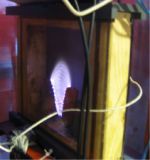EPJ D Highlight - How hypergravity impacts electric arcs
- Details
- Published on 16 December 2013

A new study focused on electric discharge behaviour under intense gravitational forces shows that its dynamic changes as gravity increases
Arc discharges are common in everyday conditions like welding or in lightning storms. But in altered gravity, not as much is known about the behaviour of electric discharges. For the first time, Jiří Šperka from Masaryk University, Czech Republic, and his Dutch colleagues studied the behaviour of a special type of arc discharge, so-called glide arc, in varying hypergravity conditions, up to 18 G. In a paper just published in EPJ D, they demonstrate how the plasma channel of this glide arc discharge moves due to external forces of buoyancy in varying gravity conditions. These results could have implications for improved safety precautions in manned space flights, and in the design of ion thrusters used for spacecraft propulsion.
Though electric discharges can be affected by gravity, the electromagnetic forces between charged particles are typically much stronger than any gravitational forces. Therefore, in order to understand this effect, the authors designed an experimental device to perform measurements on atmospheric pressure glide arc helium plasma under the forces of hypergravity.
They changed the buoyancy force acting on the plasma channel of the glide arc while maintaining a constantly low external gas flow. To do so they relied on the Large Diameter Centrifuge at the European Space Agency’s European space research and technology centre (ESTEC) facility in Noordwijk, the Netherlands.
They found that gravity strongly influences the glide arc discharge. These effects stem from thermal buoyancy, which increases with gravity. As such, increasing the centrifugal acceleration of gravity makes the glide arc movement substantially faster. Whereas at 1 G the discharge was stationary, at 6 G it glides with 7 Hz frequency and at 18 G that number rises to 11 Hz. The authors thus established a simple model for the glide arc movement assuming low gas flow velocities, which they validated with experimental results.
Hypergravity Effects on Glide Arc Plasma, J. Sperka, P.Souček, J. J.W.A. Van Loon, A. Dowson, C. Schwarz, J. Krause, G. Kroesen, V.Kudrle (2013), European Physical Journal D 67: 261, DOI 10.1140/epjd/e2013-40408-7




